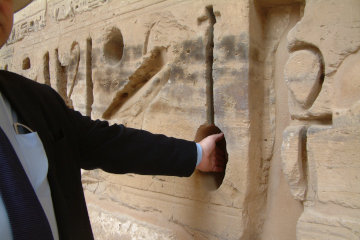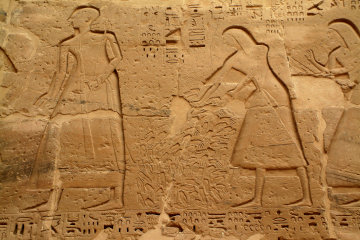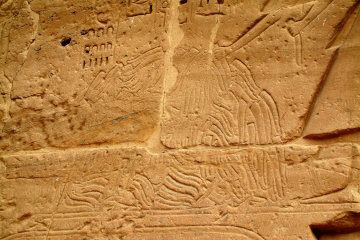Counting the Dead
As most people are aware, there is only one reference to Israel in the whole of Egyptian literature. Amid the thousands of hieroglyphic inscriptions on tombs and temple walls, the tens of thousands of papyrii, the paintings, reliefs and frescos, there is only one stele which refers to Israel - the Merneptah Stele.

| |
| The Merneptah Stele in the Cairo Museum |
As it happens, the stele inscription is very useful. Merneptah was the son of Rameses II and the fact that he refers to Israel as one of the nations in Palestine is proof that the Exodus cannot have been any later than the time of Rameses II. This is very annoying to those sceptics who would like to deny an early date for anything that is mentioned in the Bible.
Of course, it isn't much help to those who think that Israel left Egypt a good deal earlier than the time of Rameses II, because those who are experts in hieroglyphs tell us that the way the name "Israel" is written shows that it was not yet a recognised nation, just a tribe or people.
As is well known, hieroglyphs are picture writing, but - Chinese notwithstanding - it is impossible to come up with a different picture for every word and concept you might wish to express. So the Egyptians used their hieroglyphic symbols in a variety of ways. For example, a picture of a bee might represent the flying insect, the bee. It might be a syllable that is part of a longer word - "be-fore". Or it might be just the letter "b". Then, of course, there was the problem of homophones - words which have the same sound but entirely different meanings. Is "leaf" a part of a plant, a page in a book or is it a verb describing how you page your way through a book?
To help solve such ambiguities, the Egyptian scribes would use symbols before the hieroglyhic word to indicate the class of objects to which it belonged. I can imagine that you might put a plant before "leaf" if you wanted the word to indicate that green thing hanging off a tree, a book to indicate a page, and someone licking his finger to indicate the verb! These signs are called "determinatives".

| |
| Detail of the word "Israel" on the Merneptah Stele. |
In the case of Merneptah's mention of Israel the determinatives before the word are a throwing stick, a sitting man and woman, and beneath them three strokes which indicate plurality. The throwing stick indicates that the word which follows relates to something foreign; the seated man and woman indicate that the following word has to do with people, and the three strokes show that there are many of them. Put together they indicate a numerous foreign people. However there was a perfectly good determinative for foreign people, so scholars conclude that this collection of determinatives indicate a nomadic people, people without a fixed dwelling or city.
If we at Diggings are right in identifying the Exodus as taking place at the end of Early Bronze I, the archaeological evidence is that during the period which followed, Palestine was occupied by nomads who eschewed city life and only gradually came to live in and rebuild the ruined cities of the preceding period. This would certainly justify Merneptah's determinatives.
However, back to Merneptah. The line in his inscription which mentions Israel says, "Israel is laid waste, his seed is not". To my untutored eye, the expression "his seed is not" means that a large number of Israelites have been killed or carried away into captivity, but others have suggested that the words mean that Israel's crops or their stores of food have been destroyed. Indeed, that appears to be the interpretation favoured by Wikipedia.

| |
| Rameses III wanted to make sure that no one could erase or appropriate his inscriptions! |
I was interested recently to read the translation of the Medinet Habu temple inscriptions by J.H.Breasted and discover that the same expression was used by Rameses III to describe his various victories. For example, when talking about the conquest of a nation called the "Amor", he says:
Gored is the chief of Amor in his blood, his seed is not, all his people are taken captive, carried off, spoiled.
Another inscription from the same place depicts the defeated foes as lamenting over pharaoh's prowess:
He is behind us, slaughtering, and he has no pity. He has turned us back from the boundaries of Egypt forever. The fire has penetrated us, our seed is not.
Finally there is the long inscription on the second pylon in which Rameses III describes his defeat of the invading Peoples of the Sea.
I, King Rameses III, was made a far-striding hero, conscious of his might, valiant to lead his army in the day of battle. Those who reached my boundary, their seed is not; their heart and their soul are finished forever and ever.
I don't see any way of making those claims refer to stores of grain, burned barns or ravaged crops. They are quite clearly references to widespread slaughter and extensive carrying off of prisoners. In the case of the Peoples of the Sea, pharaoh never went near their crops - they were the ones coming to invade Egypt and who were defeated and slain in a great battle, after which Rameses III returned home.
If, then, Merneptah was boasting of having killed or captured large numbers of Israelites, it is reasonable to ask whether the Bible records any such successful invastion of Israelite territory. If the scholars are correct in interpreting the determinatives as referring to a semi-settled, semi-nomadic people, then we are probably looking at the period of the Judges rather than what appears to be more settled times under the Hebrew kings.
The Biblical book of Judges records a number of invasions of Israelite territory, but never by the Egyptians. Towards the end of the book of Judges the Philistines emerge as the great opponents of the Israelites and most scholars believe that the Philistines first appear in the historical record during the time of Rameses III. Merneptah ruled a mere thirty years before Rameses III and even if we accept the suggestion that half a century at least must elapse between Rameses III and the Philistines of Judges, there is still silence concerning any Egyptian interference in Canaan.
One solution to the problem might be that Judges only records those foreigners who occupied and oppressed Israel for a period of time. If Merneptah's conquest was merely a hit and run raid, that might explain why it is not mentioned by the author of Judges.
However another explanation is possible. Just as Egyptian scribes studiously ignored Israel - national humiliation is hard to forgive - so the Jewish scribes may have done the same thing. Israel's slavery in Egypt could not be entirely forgotten, but a short-lived victory by the hated Egyptians would certainly not be recorded. Even if it was recorded, it was probably edited out by whoever edited out the names of the kings of Egypt and simply referred to them by the anonymous and anachronistic title of "pharaoh".

| |
| Egyptian scribes counting a pile of severed hands, from the temple of Medinet Habu. |
Medinet Habu has another interesting link with Bible times. The reliefs on the walls of Medinet Habu depict Rameses III's conflict with the invading "Peoples of the Sea" and there are two scenes where scribes are shown counting the number of the slain. In the first the scribes are counting a mound of severed hands; in the second they are counting something much more personal!
I presume that at the beginning of the war Rameses offered a reward for every dead enemy soldier and decreed that a hand be brought as proof that the man was indeed dead. Human nature being what it is, the authorities quickly noticed that a substantial number of Egyptian dead were discovered to be lacking their right hands, so clearly the Egyptian soldiers were harvesting the hands of their dead comrades as well as those of the enemy!
The solution, depicted in the second scene, was ingenious and effective. The Egyptians practised circumcision, the Philistines did not. Instead of hands the Egyptian soldiers now had to bring in something else and a glance would be sufficient to verify that there was no imposture. Of course Egyptian reliefs are not always to scale, but if they were, I would have to assume that Philistine women were very lucky indeed!

| |
| Egyptian scribes counting a pile of severed phalli, from Medinet Habu. |
The Bible tells the story of how King Saul wanted to trap young David and get him killed, so he offered to let him marry a royal princess provided he brought as dowry four hundred Philistine "foreskins" - which David duly did and so earned his bride. A foreskin is small, fiddly to remove, and rather gruesome to have to transport and count, so I was interested to read another part of the Medinet Habu inscriptions.
Bound are their mighty men upon the place of slaughter, they are made into pyramids upon the ground, by the might of the king. They come forth, carried off as captives to Egpt, the hands and foreskins are without number.
It is possible, of course, that Breasted (1865-1935) was employing a euphemism for what Rameses III actually wrote, but if not it is interesting that the inscription should refer to mounds of "foreskins" when the reliefs make it plain that it was the whole phallus that was being piled up and counted.
And, of course, if the Egyptians employed the term "foreskin" to indicate the whole thing, it is more than likely that the author of 1 Samuel did the same and what David brought to King Saul was not 400 tiny pieces of skin but sacks and sacks of ... yes, well, it makes your eyes water to think about it!
============
pharaoh The names of Egyptian kings almost always incorporated the name of one or more of the Egyptian gods; that on its own would be sufficient reason to remove the names. It is almost certain that the name of Israel's great leader was also edited: "Moses" is linguistically identical to the last part of names such as Ra-meses, Thot-mosis, or even Ka-mose. The word means "drawn out of" and as Moses was found floating in the Nile it is possible that he was named "drawn out of the Nile God Hapi". Hapi-moses doesn't trip off the tongue as easily but may be more accurate!
In addition, by naming someone you, in a sense, ensured his immortality. The Bible contains numerous references to children preserving your name into the future. By deliberately forgetting the names of the Egyptian kings who oppressed Israel, the Jews were doing their part towards depriving them of immortality.
"Phar-aoh" simply means "white house" and refers to the royal palace. The word was not used to refer to the Egyptian ruler until the time of Merneptah, long after the events of Genesis and Exodus. Return
© Kendall K. Down 2019





